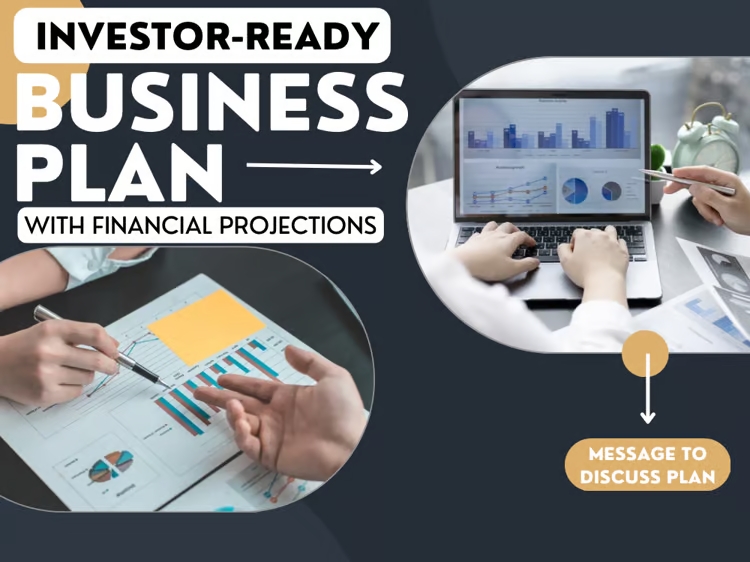Description
Creating an investor or bank-ready business plan involves crafting a comprehensive document that clearly presents your business model, market strategy, and financial projections. Below is a detailed outline of such a business plan, including the critical sections and financial projections required to attract investors or secure a bank loan.
Business Plan Outline
1. Executive Summary
- Company Overview: Brief description of your business, including the name, location, and nature of your business.
- Mission Statement: A concise statement of your business’s purpose and core values.
- Business Objectives: Specific, measurable goals you aim to achieve in the short and long term.
- Products/Services: A brief overview of what your business offers.
- Market Opportunity: Summary of the market need your business addresses.
- Financial Highlights: Key financial projections, including expected revenue, profit, and funding requirements.
- Funding Request: The amount of funding you are seeking, how it will be used, and the benefits to the investor or lender.
2. Company Description
- Business History: Background of the business, including its founding and major milestones.
- Business Structure: Legal structure (e.g., sole proprietorship, LLC, corporation).
- Ownership: Details about the owners and their respective shares.
- Location: Description of your business premises and why it’s strategically located.
3. Market Analysis
- Industry Overview: Insights into the industry, including size, growth rate, and trends.
- Target Market: Detailed description of your ideal customer demographics and psychographics.
- Market Needs: The specific needs and pain points your business addresses.
- Competitive Analysis: Identification of key competitors, their strengths and weaknesses, and your competitive advantage.
- Market Size and Growth: Data and projections on the market size and expected growth.
4. Organization and Management
- Organizational Structure: An organizational chart outlining the internal structure.
- Management Team: Detailed bios of the management team, highlighting relevant experience and expertise.
- Advisors: Information on any external advisors or board members.
5. Products and Services
- Product/Service Description: Detailed description of your products or services.
- Unique Selling Proposition: What makes your product/service unique or superior.
- Research and Development: Information on any ongoing R&D and future product development plans.
- Intellectual Property: Patents, trademarks, or other IP rights.
6. Marketing and Sales Strategy
- Marketing Strategy: Comprehensive marketing plan including market positioning, pricing strategy, promotional tactics, and distribution channels.
- Sales Strategy: Sales processes, sales team structure, and sales goals.
- Customer Acquisition: Strategies for attracting and retaining customers.
- Marketing Budget: Detailed budget for marketing activities.
7. Operations Plan
- Operational Process: Detailed explanation of how your business operates on a day-to-day basis.
- Location and Facilities: Description of your operational facilities and their adequacy.
- Technology and Equipment: Overview of any technology or equipment critical to operations.
- Supply Chain Management: Details on your supply chain and key suppliers.
- Quality Control: Measures in place to ensure product/service quality.
8. Financial Plan
- Key Assumptions: Assumptions that underlie your financial projections, such as growth rates and market conditions.
- Income Statements: Projected income statements for the next 3-5 years.
- Cash Flow Statements: Projected cash flow statements for the next 3-5 years.
- Balance Sheets: Projected balance sheets for the next 3-5 years.
- Break-even Analysis: Calculation of the break-even point.
- Funding Requirements: Detailed explanation of the amount of funding required, the purpose of the funds, and the timing.
- Use of Funds: How the funding will be allocated.
- Financial Ratios: Key financial ratios and metrics, such as profit margins, return on investment (ROI), and debt-to-equity ratio.
9. Appendix
- Supporting Documents: Any additional documents that support the business plan, such as resumes of key personnel, legal agreements, detailed market research data, and product/service images.
Financial Projections
1. Income Statements
- Revenue Projections: Detailed forecasts of sales revenue, broken down by product line or service.
- Cost of Goods Sold (COGS): Expected costs directly associated with producing goods or services sold.
- Gross Profit: Revenue minus COGS.
- Operating Expenses: Detailed listing of operating expenses such as salaries, rent, utilities, marketing, and R&D.
- Net Profit: Gross profit minus operating expenses and taxes.
2. Cash Flow Statements
- Cash Inflows: Expected cash receipts from sales, investments, and other sources.
- Cash Outflows: Expected cash payments for expenses, capital expenditures, and debt repayment.
- Net Cash Flow: Difference between cash inflows and outflows.
- Cash Flow Surplus/Deficit: Projection of periods where cash flow will be positive or negative.
3. Balance Sheets
- Assets: Listing of all assets, including current assets (cash, receivables, inventory) and long-term assets (property, equipment).
- Liabilities: Listing of all liabilities, including current liabilities (accounts payable, short-term debt) and long-term liabilities (long-term debt).
- Equity: Owner’s equity, including retained earnings and any new equity investments.
4. Break-even Analysis
- Break-even Point: Calculation of the sales volume at which total revenues equal total costs, resulting in zero profit.
- Contribution Margin: Sales price per unit minus variable cost per unit.
- Fixed Costs: Total fixed costs that do not vary with production volume.
5. Funding Requirements and Use of Funds
- Total Funding Needed: Specific amount of funding required.
- Allocation of Funds: Detailed plan on how the funds will be used, such as for marketing, equipment purchase, staffing, or R&D.
- Milestones and Timeline: Key milestones to be achieved with the funding and the associated timeline.
Final Steps
- Proofread and Review: Ensure the business plan is free of errors and clearly presents your business case.
- Professional Presentation: Format the business plan professionally, with consistent fonts, headings, and subheadings.
- Seek Feedback: Get feedback from mentors, advisors, or business consultants.
- Prepare for Questions: Be ready to answer detailed questions from investors or lenders about every aspect of your business plan.
A well-crafted business plan not only helps in securing funding but also serves as a roadmap for the growth and development of your business.





Grace –
If you’re looking for a freelancer to create an investor-ready business plan with financial projections, look no further than him. His attention to detail and strategic approach set them apart. He worked closely with me to develop a plan that not only impressed potential investors but also provided me with a clear roadmap for success.
Aminu –
I can’t thank him enough for their outstanding work on my business plan. He took the time to understand my vision and goals, and then crafted a comprehensive plan that exceeded my expectations. His financial projections were particularly impressive and played a crucial role in securing funding from investors.
Samuel –
Working with him was a game-changer for my business. His investor-ready business plan, complete with detailed financial projections, helped me secure the funding I needed to take my venture to the next level. His expertise and attention to detail were evident throughout the process.